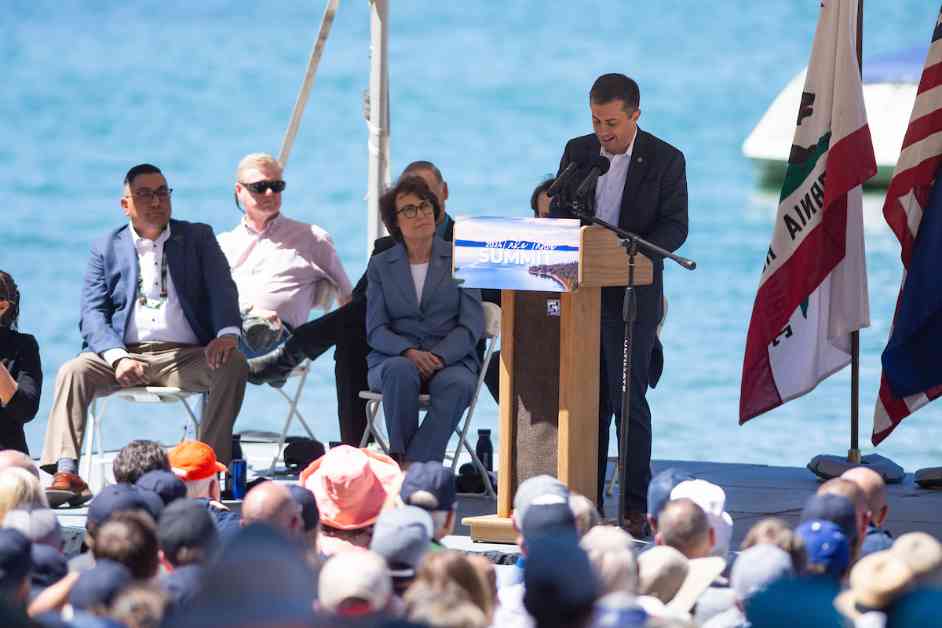Improving Transportation and Trails at Lake Tahoe Summit: Alleviating Overcrowding
For decades, the challenge of connecting the small cities and tourist destinations around the Lake Tahoe Basin has been a topic of discussion. The vast lake and rugged mountain landscape have posed obstacles to efficient transportation in the region. After the 1960 Winter Olympics in North Lake Tahoe, proposals for a cement bridge over Emerald Bay and a four-lane highway circumnavigating Lake Tahoe were considered, but these projects never materialized.
The issue of moving the basin’s millions of annual visitors while minimizing traffic congestion and environmental impact remains a top priority for stakeholders invested in the future of Lake Tahoe. Lawmakers from both California and Nevada gathered at the 28th annual Lake Tahoe Summit at Round Hill Pines to address the transportation challenges facing the region. This year also marks the 55th anniversary of the Bi-State Compact that established the Tahoe Regional Planning Agency (TRPA) to oversee efforts to preserve and restore Lake Tahoe.
The theme of this year’s summit, “Connecting Tahoe: Investing in Transit, Trails, and Technology for the Future,” underscored the importance of ongoing projects aimed at tackling overcrowding on Tahoe’s roads and reducing runoff that contributes to the lake’s declining clarity. Senator Catherine Cortez Masto (D-NV), the host of the summit, emphasized the crucial role of transportation infrastructure in supporting Tahoe’s economy.
One significant development highlighted at the summit was the allocation of $24 million in federal funds to support the Tahoe East Shore Trail improvement project and safety initiatives along State Route 28. This 16.3-mile highway runs from Spooner Junction north to Incline Village and has been a focal point for addressing traffic congestion and parking challenges in the region.
Pete Buttigieg, the U.S. Secretary of Transportation, commended Nevada’s congressional delegation and local stakeholders for securing the funding for the Tahoe East Shore Trail project. He emphasized the importance of trails in creating a safe and efficient transportation system, stating, “Trails are not ornamental. They are fundamental to a good and safe transportation system.”
The Tahoe East Shore Trail project aims to enhance parking, connectivity, and public transportation along State Route 28. It includes the construction of a 250-space park-and-ride facility at the top of Spooner Summit, a watercraft inspection station, and new parking areas at Chimney Beach, Secret Cove, and Skunk Harbor. These parking areas will be connected by public transportation and a paved trail system, along with erosion control measures to protect the environment.
A 2017 TRPA report highlighted the shortage of parking spaces in the basin, with one spot available for every 9,176 visitors. Critical parking shortages were identified along the East Shore at Sand Harbor and Incline Village. The Tahoe East Shore Trail project aims to address these parking issues and provide alternative transportation options for visitors to reduce congestion and sediment runoff into the lake.
The project also includes the construction of a 1.75-mile trail connector from Sand Harbor to Thunderbird Lodge, further enhancing access and connectivity along the East Shore. While the project has received support from many stakeholders, some residents have expressed concerns about the impact of the trail on the local environment and community.
Efforts to reduce the number of cars driving along the lake and parking illegally on State Route 28 are essential for mitigating sediment transportation into Lake Tahoe. According to a TRPA spokesperson, nearly three-quarters of the fine sediment entering the lake originates from the basin’s developed areas, with roadways being the primary carriers. A proposed bill aims to establish a Lake Tahoe Basin Scenic Byway Corridor Recreation Safety Zone to address illegal parking issues along key routes in the region.
Lawmakers at the Lake Tahoe Summit celebrated the progress made in securing funding for transportation and environmental projects in the basin. The Lake Tahoe Restoration Act, a multi-million-dollar fund for environmental initiatives, is set to expire in October, prompting efforts to reauthorize the funding to support ongoing conservation efforts around the lake.
The Lake Tahoe Restoration Act was initially passed in 2000, providing $300 million for environmental projects, and was reauthorized in 2016 with an increased funding allocation of $415 million. The fund has supported various projects, including trail construction and invasive species removal, contributing to the preservation of Lake Tahoe’s natural beauty and ecological health.
With $300 million still available in the fund, lawmakers are working to secure reauthorization before the expiration date to ensure continued support for environmental projects in the Lake Tahoe Basin. The bipartisan, bi-state effort to extend the Lake Tahoe Restoration Act through 2034 has garnered support from key legislators, including Senators Cortez Masto, Feinstein, Rosen, and Padilla.
In honor of the late Senator Dianne Feinstein, who played a significant role in protecting Lake Tahoe, the West Shore Trail will be renamed the “Dianne Feinstein West Shore Trail.” This tribute recognizes Feinstein’s legacy of environmental stewardship and dedication to preserving the natural beauty of Lake Tahoe for future generations.
As lawmakers continue to advocate for the reauthorization of the Lake Tahoe Restoration Act and address transportation challenges in the region, the future of Lake Tahoe’s environmental preservation and sustainable transportation infrastructure remains a top priority. With ongoing investments in transit, trails, and technology, stakeholders are committed to ensuring the long-term health and vitality of Lake Tahoe for residents and visitors alike.



